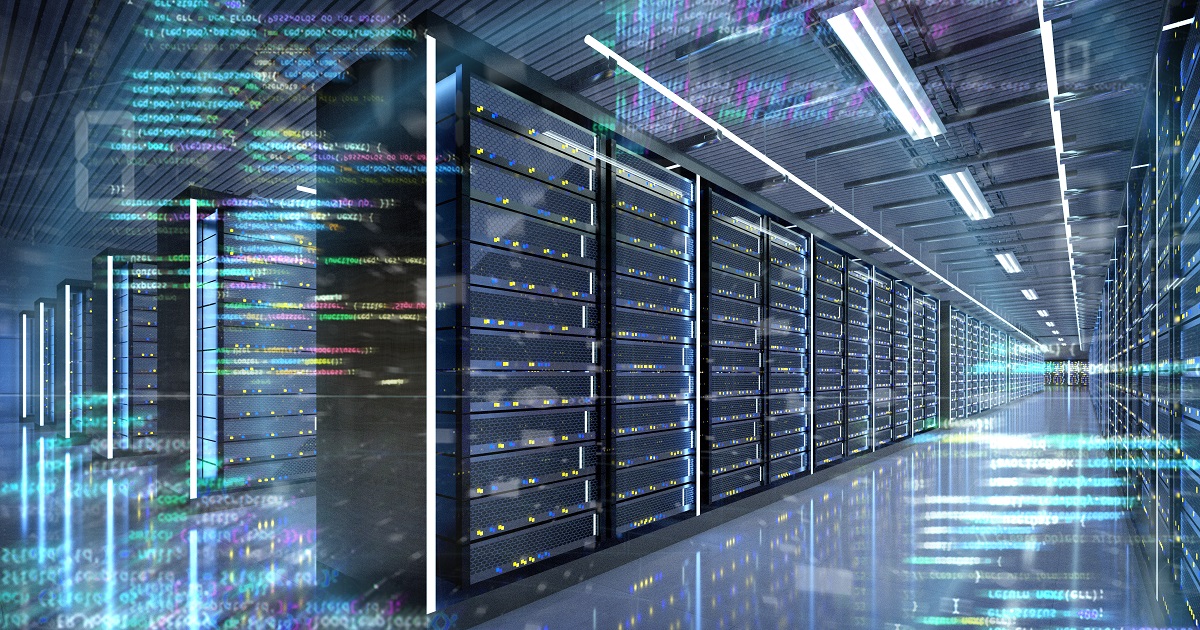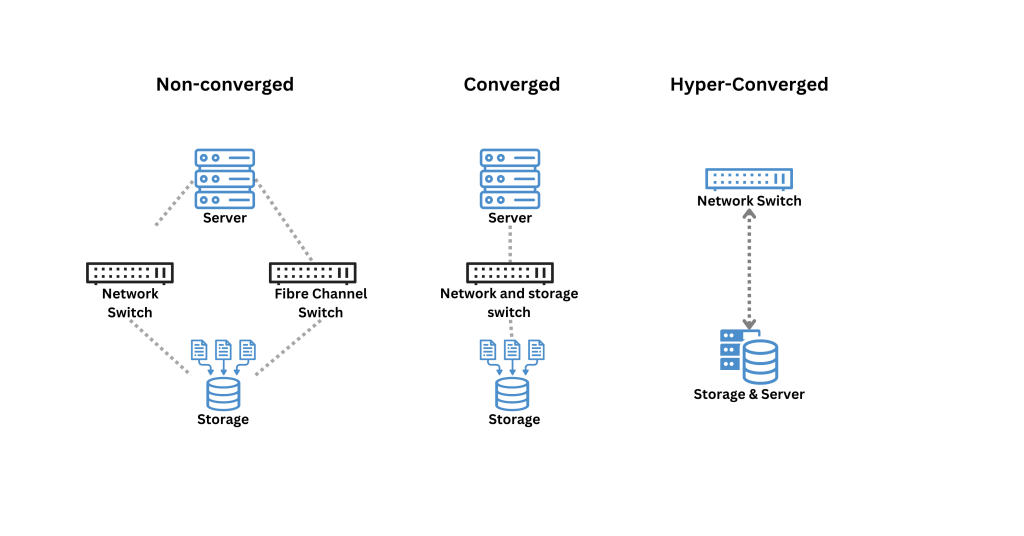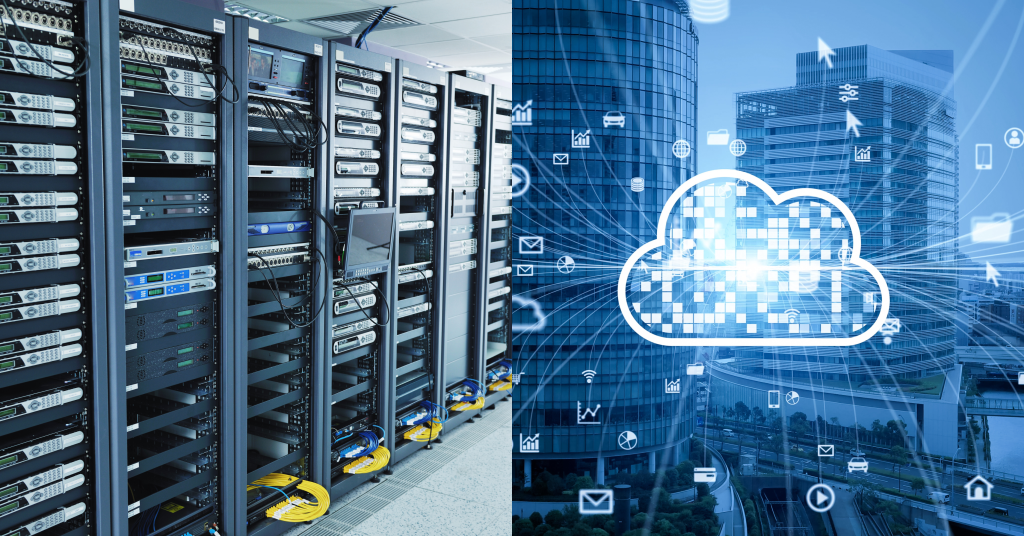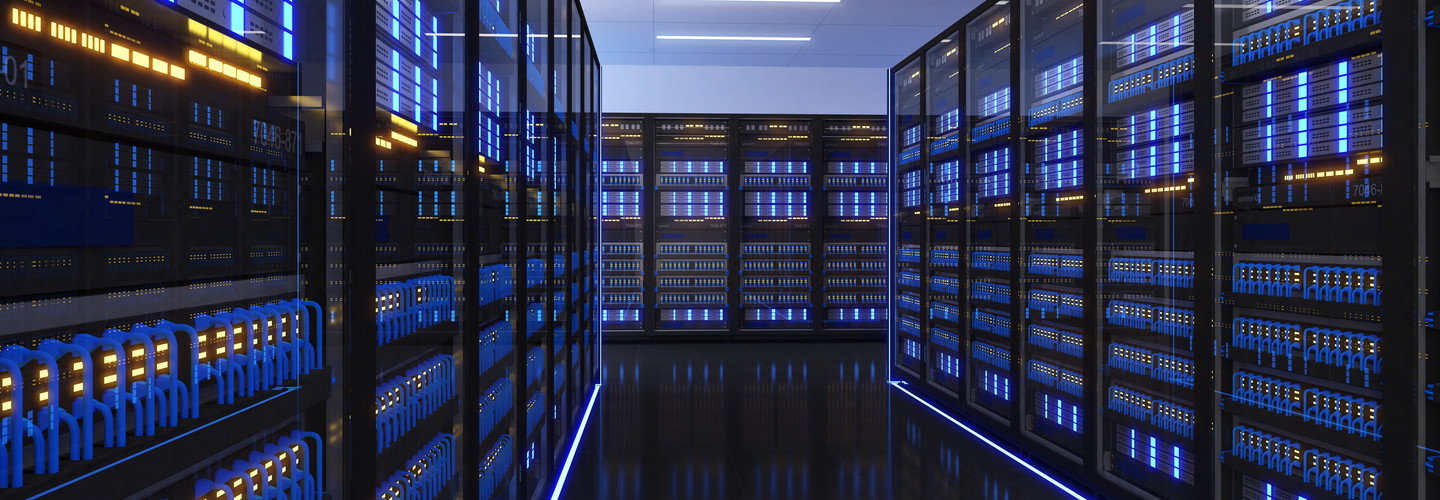In today’s rapidly evolving technological landscape, businesses face diverse demands and varying business needs. Whether it’s the need for increased agility, scalability, cost optimization, or streamlined IT operations, Hyper Converged Infrastructure (HCI) has emerged as a critical solution to address these challenges. One of the primary reasons businesses need HCI is its ability to simplify IT infrastructure and operations.
What is Hyper-Converged Infrastructure (HCI)?
Hyper Converged Infrastructure integrates compute, storage, and networking resources into a single, software-centric system. Instead of managing separate servers, storage racks, operating systems, and software tools, HCI brings everything together. This includes virtualization platforms and software management tools.
Hyperconverged systems operate through a powerful combination of virtualization technology and unified management. Virtualization enables the resources – compute, storage, and networking – to be centrally provisioned and managed. Unified management lets all those resources be discovered, organized into pools, divided into performance tiers, and then seamlessly provisioned to workloads regardless of where those resources are physically located.
This combination of virtualized hardware and associated management tooling is often treated as a standalone appliance. This appliance can operate as a single, complete hyperconverged system in the data center. Alternatively, it can be combined with other HCI appliances to quickly and easily scale up a hyperconverged infrastructure deployment.
Hyperconverged infrastructure is founded on the two essential premises of integration and management. The goal of HCI is to deliver virtualized and scalable compute, storage, and network resources that are all discoverable and managed through a single pane of glass. This simplifies IT operations and makes it easier for businesses to achieve their goals.
The Benefits of Hyper-Converged Infrastructure (HCI)
HCI consolidates these elements into a unified platform, eliminating the need for separate hardware and streamlining IT operations. With Hyper Converged Infrastructure, businesses benefit from a simpler and more cohesive infrastructure, leading to improved efficiency and reduced complexity in day-to-day management tasks. Flexibility is another key factor driving the adoption of HCI in businesses. In today’s dynamic market, organizations need the ability to scale their IT resources rapidly and efficiently to meet changing business demands. HCI offers inherent scalability, allowing businesses to easily add or remove computing and storage resources as needed. This flexibility enables organizations to align their IT infrastructure with their evolving requirements, ensuring optimal performance while avoiding underutilization or overprovisioning of resources. Whether it’s scaling up to accommodate a sudden surge in workloads or scaling down during periods of low demand, HCI provides the agility businesses need to stay responsive and adaptable. Cost optimization is a crucial consideration for businesses of all sizes. Traditional infrastructure often requires significant upfront investments and ongoing operational expenses. HCI presents an opportunity for potentially cheaper IT as it combines computing, storage, and networking in a single platform. By eliminating the need for separate hardware components, businesses can reduce capital expenditures and optimize their IT spending. Additionally, HCI’s streamlined management and automation capabilities contribute to cost savings by reducing the need for dedicated IT staff and simplifying routine maintenance tasks.
HCI also offers businesses a comprehensive solution to address their modern computing requirements. With advanced applications such as data analytics, artificial intelligence, and machine learning becoming increasingly prevalent, businesses need robust computing power and efficient data storage. HCI provides the necessary infrastructure to support these workloads, offering Supercomputing resources, scalable storage capacities, and seamless integration with emerging technologies. By leveraging HCI, businesses can harness the full potential of these advanced applications, gaining valuable insights, driving innovation, and staying competitive in their respective industries.


Features of Hyper-Converged Infrastructure (HCI)
Agility and scalability
One of the key features of the adoption of HCI is increased agility and scalability. As businesses and academic institutions strive to stay competitive and innovative, they require an infrastructure that can rapidly scale up or down to accommodate fluctuating workloads. HCI provides a flexible and scalable architecture that allows organizations to add or remove resources as needed, ensuring optimal performance and cost efficiency.
Data efficiency and reduced complexity
Moreover, HCI offers improved data efficiency and reduced complexity. By converging computing, storage, and networking into a single platform, organizations can eliminate redundant hardware, reduce data center footprint, and simplify deployment and management processes. This streamlined approach not only saves valuable physical space but also reduces power consumption and lowers operational costs.
Enhanced Data Protection and Resilience
HCI brings built-in data protection and resilience features, ensuring the integrity and availability of critical business data. With integrated backup and replication capabilities, organizations can easily create data backups, perform disaster recovery, and ensure business continuity. HCI's distributed architecture and data redundancy mechanisms provide fault tolerance, minimizing the risk of data loss and downtime. This feature offers businesses peace of mind and helps them meet their data protection and compliance requirements effectively.
Simplified Management and Automation
HCI simplifies IT management through centralized and unified management interfaces. It provides a single pane of glass view, allowing administrators to monitor and manage the entire infrastructure from a unified dashboard. This comprehensive management approach streamlines routine tasks, reduces administrative overhead, and improves efficiency. Additionally, HCI platforms often offer automation capabilities, enabling organizations to automate repetitive tasks, streamline deployment processes, and optimize resource utilization. By automating tasks such as provisioning, scaling, and workload management, businesses can save time, increase productivity, and focus on strategic initiatives.
The difference among non-converged, converged & hyper-converged infrastructure
Traditional (Non-Converged) Infrastructure
This is the original setup, where computing, storage, and networking are all separate components. Each needs individual configuration and management by dedicated IT teams, leading to complexity and higher costs. Imagine juggling multiple systems with separate teams – it’s cumbersome and expensive.
Converged Infrastructure (CI)
CI offers a pre-built solution where servers, storage, and networking come together in a single, pre-configured appliance. This “out-of-the-box” approach simplifies initial setup and reduces costs associated with cabling, power, and cooling. However, scalability can be limited, and you might still need some dedicated IT expertise for specific tasks.
Hyper-Converged Infrastructure (HCI)
HCI takes things a step further by leveraging software to combine industry-standard (x86) servers and storage resources. It’s essentially a 100% software-defined solution. Unlike CI, HCI incorporates storage directly into the server using software, eliminating the need for separate storage hardware like a SAN. This software-centric approach offers superior scalability and allows for easier management through a single interface. It’s like having a unified team managing all your resources, streamlining operations and reducing complexity.

Hyper-converged infrastructure (HCI) vs Cloud
Use: Although cloud computing and HCI both handle IT issues, their goals are distinct. For instance, processing massive volumes of data that either rise steadily or remain constant is a good fit for HCI. It also simplifies the process of eventually migrating some of your workloads to the cloud. If your needs for data storage are dynamic and ever-changing, cloud computing is a better fit.
Cost: Since you only pay for the resources you use, cloud solutions have low upfront costs, which makes them appealing. For this reason, a lot of companies use “cloud-first” approaches. But, as your usage grows, cloud fees may rise significantly and may even surpass the total cost of ownership (TCO) of HCI in the long run.Conversely, HCI provides cost transparency from the outset. Companies can decide whether to buy or lease hardware, which makes it possible to plan ahead for regular maintenance and replacement costs. This upfront clarity helps you make informed decisions about your IT infrastructure.
The Hybrid Approach: Many businesses are adopting a hybrid infrastructure that makes smart use of both options. Data management and control for predictable data expansion are areas in which HCI excels. On the other hand, resource flexibility and dynamic scalability are provided by cloud computing. With a hybrid infrastructure, businesses may take advantage of the cloud’s natural agility as well as on-premises control via HCI.

Market Trend for Hyper-Converged Infrastructure (HCI)
The market trend for HCI has been steadily growing as organizations recognize its transformative benefits. According to industry reports, the HCI market is expected to experience significant growth in the coming years. Factors driving this growth include the increasing demand for data-intensive applications, the rise of hybrid and multi-cloud environments, and the need for simplified IT management.
Furthermore, HCI technology providers, such as Nutanix, have been at the forefront of driving innovation in this space. They continue to enhance their offerings with advanced features like automation, AI-driven analytics, and seamless integration with public cloud services. These developments further facilitate organizations in harnessing the full potential of HCI and unlocking new possibilities for their computing needs.
In summary, Hyper-Converged Infrastructure (HCI) is a crucial solution for organizations facing the escalating demands of advanced applications and data-intensive workloads. Its ability to streamline infrastructure, enhance scalability, and simplify management makes it an ideal choice for businesses and academic institutions seeking powerful, efficient, and future-ready computing capabilities. With the market trend leaning towards HCI adoption and ongoing advancements in the field, organizations can leverage this transformative technology to stay ahead in an increasingly competitive landscape.


OneAsia: A Leading HCI Provider of More Flexible & Practical Cloud Solutions
OneAsia is a leading provider of Hyper-Converged Infrastructure (HCI) solutions & services in Hong Kong. We collaborate with Nutanix, a hybrid multi-cloud computing company, to deliver flexible and practical cloud solutions to enterprises in the region. Leveraging Nutanix’s hyper-converged infrastructure (HCI) technology, OneAsia HCI Cloud offers organizations the opportunity to subscribe to cloud and HCI services on a monthly basis, providing greater flexibility and cost control.
OneAsia’s HCI service offers a range of key features designed to meet the specific needs of Hong Kong enterprises. Flexibility and scalability are at the core of our offering, allowing businesses to easily adjust their infrastructure resources according to their requirements. By combining the convenience of Infrastructure as a Service (IaaS) with on-site infrastructure, organizations can avoid upfront capital investments and dynamically allocate resources as needed.
Data security is a top priority for OneAsia, and our partnership with Nutanix enables us to integrate their advanced security measures into our HCI service. With features such as platform hardening, security audits, reporting, and protection against cyber threats, we provide businesses with enhanced data security and ensure the integrity of their critical information.
We understand the importance of simplifying infrastructure management. With OneAsia’s HCI service, businesses gain access to a centralized platform for monitoring and control, streamlining resource management, optimizing performance, and reducing administrative overhead. By simplifying IT operations, organizations can focus on delivering value-added services and driving innovation.
Sustainability and cost efficiency are also key considerations. Through our collaboration with Nutanix and the integration of their Cloud Platform with our supported hardware, we enable organizations to meet their storage and IT governance requirements without the need for local datacenters. This approach helps reduce datacenter footprints and power consumption, resulting in cost savings and a more sustainable IT infrastructure.
Additionally, OneAsia offers streamlined manpower through our agile managed cloud solutions. Our team of IT specialists takes care of managing customers’ clouds, overseeing and maintaining the infrastructure. This centralized approach frees up customers’ internal IT personnel, allowing them to focus on more value-added tasks and strategic initiatives.


Target Segments for Hyper-Converged Infrastructure (HCI)
OneAsia’s Hyper converged Infrastructure service caters to a wide range of industries and enterprises in Hong Kong. Some of the target segments for HCI adoption may include:
Small and Medium-sized Enterprises (SMEs)
SMEs often have limited IT resources and budgets. OneAsia's HCI service allows them to leverage advanced infrastructure capabilities without the need for significant upfront investments. This makes HCI an attractive option for SMEs seeking cost-effective and scalable cloud solutions.
Government Agencies
Government organizations require robust and secure IT infrastructure to support their operations and services. HCI provides a consolidated platform that simplifies management, enhances data security, and offers scalability. OneAsia's HCI service can cater to the specific needs of government agencies, helping them optimize their IT operations and deliver efficient public services.
Enterprises with Fluctuating Workloads
Businesses experiencing unpredictable or fluctuating workloads can benefit from the scalability and agility of HCI. Whether it's seasonal demand, project-based work, or rapid growth, OneAsia's HCI service allows enterprises to scale their resources up or down as needed, ensuring optimal performance and cost efficiency.
OneAsia’s Cloud and Computing Services Offering
In addition to Hyper converged Infrastructure (HCI), OneAsia also provides a comprehensive suite of cloud and computing services designed to meet the diverse needs of businesses. Our offerings include:
Public Cloud Services
Leverage the power of our scalable and secure public cloud infrastructure to enhance agility, flexibility, and cost efficiency. With our pay-as-you-go model, you can easily scale resources based on demand while only paying for what you use.
Private Cloud Solutions
Ensure the utmost control and security of your data with our private cloud solutions. Tailored to your specific requirements, our private cloud offerings provide dedicated resources and customizable configurations to meet your unique business needs.
Hybrid Cloud Deployments
Combine the advantages of public and private clouds with our hybrid cloud deployments. Achieve optimal flexibility, scalability, and data control by seamlessly integrating on-premises infrastructure with the cloud.
Managed Services
Offload the complexities of IT infrastructure management with our comprehensive managed services. Our team of experts will handle the day-to-day operation and maintenance of your cloud environment, allowing you to focus on core business objectives.
Disaster Recovery and Business Continuity
Protect your critical data and ensure business continuity with our robust disaster recovery solutions. Benefit from automated backup, replication, and failover capabilities to minimize downtime and protect against data loss.
Professional Services
OneAsia offers a range of professional services, including cloud migration, architecture design, and optimization. Our certified experts will work closely with you to design and implement the most effective cloud strategy for your business.
FAQ
What is HCI (Hyperconverged Infrastructure) and how does OneAsia leverage it in its service?
HCI, or Hyper converged Infrastructure, is a technology that consolidates compute, storage, and networking resources into a single, integrated system. By combining software-defined storage, virtualization, and management capabilities, our HCI service simplifies infrastructure deployment and management, enabling organizations to achieve greater agility, scalability, and cost-effectiveness in their IT operations.
How does OneAsia's HCI service provide flexibility for enterprises?
OneAsia’s Hyper converged Infrastructure solution & service offers flexibility by allowing enterprises to scale their infrastructure resources according to their specific needs. With the convenience of Infrastructure as a Service (IaaS) and on-site infrastructure, businesses can avoid upfront capital investments and easily adjust their resource allocations as requirements change.
How does OneAsia simplify infrastructure management with its HCI service?
OneAsia streamlines infrastructure management by providing a centralized platform for monitoring and control. This allows businesses to efficiently manage their resources, optimize performance, and reduce administrative overhead. By simplifying IT operations, organizations can focus on delivering value-added services and innovation.


